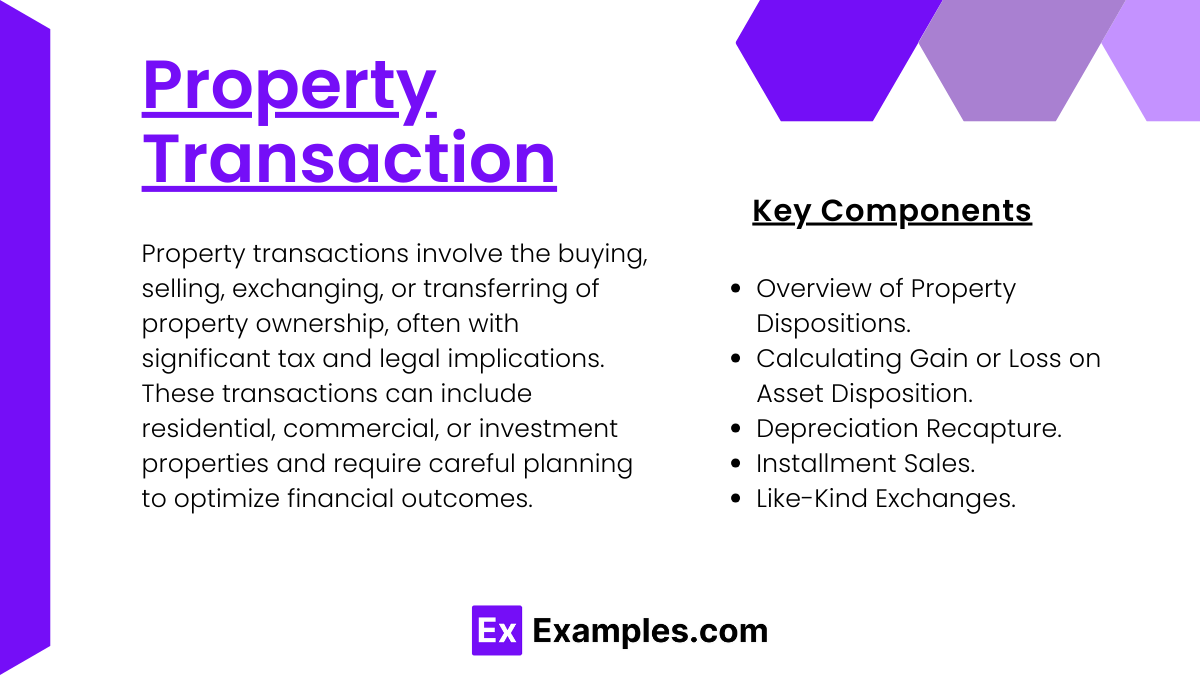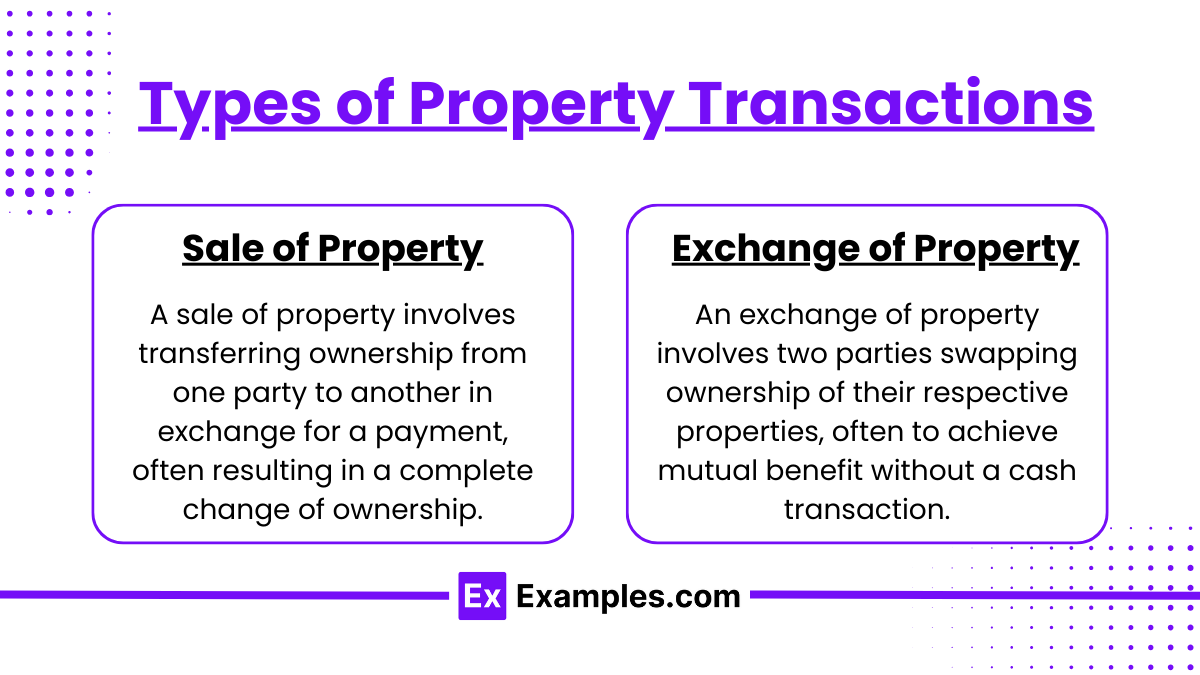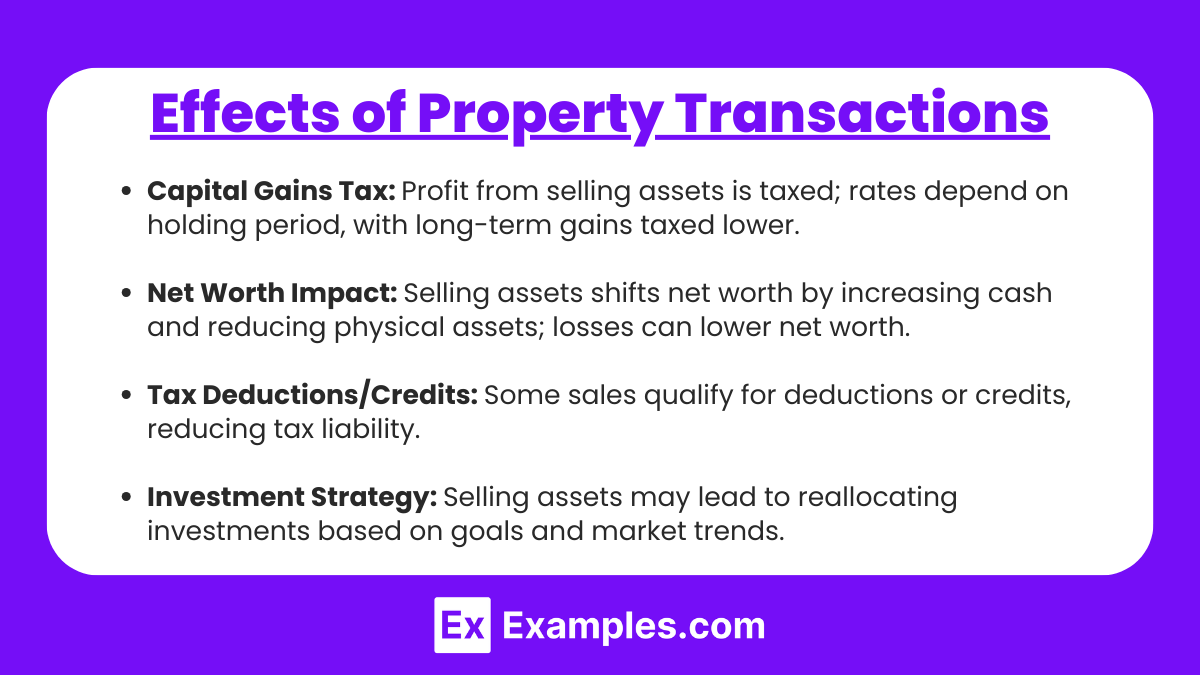Preparing for the CPA Exam’s "Area IV – Property Transactions (Disposition of Assets)" requires a thorough understanding of asset disposal, including tax implications related to sales, exchanges, and involuntary conversions. Key topics include calculating gain or loss on asset sales, understanding installment sales, and addressing like-kind exchanges under tax laws. The focus also extends to property depreciation recapture, capital gains, and losses, and navigating complex rules for personal and business property transactions. Mastery of this area ensures effective asset management, compliance with relevant tax codes, and strategic planning, all essential for achieving a high CPA score.
Learning Objectives
In studying "Area IV – Property Transactions (Disposition of Assets)" for the CPA exam, you should focus on understanding the tax implications of selling, exchanging, or otherwise disposing of property. Analyze specific tax rules governing asset dispositions, including gain or loss calculations, installment sales, and like-kind exchanges. Evaluate the effects of depreciation recapture, capital gains, and losses on different property types, such as personal, business, and investment assets. Additionally, explore the tax treatment of involuntary conversions and property abandonment. Apply your knowledge to solve case-based questions in CPA exam practice, ensuring a comprehensive understanding of asset disposition tax laws.
Key Concepts in Property Transactions

1. Overview of Property Dispositions
A property disposition refers to the sale, exchange, or abandonment of an asset.
Tax implications vary depending on the type of property—personal, business, or investment.
Key focus areas include gain or loss calculations, depreciation recapture, and the basis of assets before disposition.
2. Calculating Gain or Loss on Asset Disposition
Gain or Loss Calculation:
Formula: Amount Realized - Adjusted Basis = Gain/Loss.
Amount Realized includes all forms of compensation (cash, property, debt relief).
Adjusted Basis is the original cost basis plus capital improvements minus accumulated depreciation.
Character of Gains or Losses:
Short-term vs. long-term capital gains.
Ordinary income treatment for certain gains (e.g., depreciation recapture).
3. Depreciation Recapture
Applies to assets that have been depreciated during ownership (e.g., equipment, buildings).
Recapture rules convert some or all of the gain upon sale into ordinary income.
Two common recapture provisions:
Section 1245 Property: Recaptures all accumulated depreciation as ordinary income.
Section 1250 Property: Recaptures only the excess of accelerated over straight-line depreciation as ordinary income.
4. Installment Sales
Allows taxpayers to spread gain recognition over multiple years.
Formula: Gross Profit ÷ Contract Price = Gross Profit Percentage.
Each installment payment includes a portion of the gain.
Rules exist to prevent deferral in certain transactions (e.g., sales to related parties).
5. Like-Kind Exchanges (IRC Section 1031)
Permits the deferral of gain or loss when exchanging property used in a business or for investment.
Qualifying properties must be of like kind (e.g., real property for real property).
Non-like-kind property received ("boot") triggers partial gain recognition.
The basis of the newly acquired property is adjusted to account for deferred gain/loss.
Types of Property Transactions

1. Sale of Property
Involves the transfer of property ownership for a specific consideration.
Tax treatment depends on the type of property (personal, business, or investment).
Includes recognition of gains or losses, depreciation recapture, and potential installment sale treatment.
2. Exchange of Property
Like-Kind Exchange (Section 1031):
Involves exchanging similar business or investment properties.
Allows deferral of gain or loss but requires recognition if “boot” (non-like-kind property) is received.
Non-Qualifying Exchange:
Occurs when properties exchanged do not meet like-kind requirements, resulting in immediate gain or loss recognition.
3. Installment Sale
Sale of property where the buyer pays over time.
Gain is recognized proportionally as payments are received, spreading the tax liability across multiple years.
Commonly used for selling real estate, businesses, or other significant assets.
4. Involuntary Conversion
Results from property being destroyed, stolen, or condemned.
Taxpayers can defer gain if proceeds are reinvested in similar property within a specific period.
If reinvestment is not made, gain is recognized to the extent of proceeds not used.
5. Abandonment of Property
Occurs when a property owner voluntarily gives up ownership without receiving anything in return.
Generally results in an ordinary loss deduction, based on the remaining adjusted basis.
Effects of Property Transactions

1. Capital Gains Tax Implications
When assets are sold for a profit, capital gains tax is incurred. The gain is calculated by subtracting the asset's adjusted basis (original purchase price plus improvements minus depreciation) from the selling price. The tax rate may vary based on how long the asset was held—short-term gains are taxed as ordinary income, while long-term gains benefit from lower rates.
2. Impact on Net Worth
Disposing of assets can significantly alter an individual's net worth. Selling appreciated property increases liquid assets but reduces physical assets. Conversely, selling depreciated assets can decrease net worth if the loss exceeds gains from other transactions.
3. Tax Deductions and Credits
Certain property transactions may allow for tax deductions, such as losses on the sale of investments. Tax credits may also be available for specific transactions, which can help offset capital gains and reduce overall tax liability.
4. Investment Strategy Adjustments
The decision to dispose of assets can lead to shifts in investment strategy. Investors may reallocate funds to different asset classes or sectors based on market conditions and personal financial goals, influencing future income and capital appreciation.
Examples
Example 1. Selling Real Estate
When an individual decides to sell their property, they must understand the implications of property transactions. This includes evaluating the property's current market value, determining the best time to sell, and preparing necessary documentation such as the title deed and property disclosures. Additionally, understanding capital gains tax is crucial, as this can significantly impact the net proceeds from the sale.
Example 2. Transferring Ownership
In cases where assets are being transferred to heirs or other beneficiaries, understanding property transaction protocols is essential. This may involve gifting property, establishing trusts, or executing a will. It’s important to be aware of the tax implications associated with these transfers, including potential gift taxes and estate taxes, which can affect the overall value passed on.
Example 3. Asset Depreciation and Sale
When a business decides to sell depreciated assets, understanding how depreciation affects the sale price and tax obligations is essential. The adjusted basis of the asset, which accounts for accumulated depreciation, determines the gain or loss upon sale. It is crucial to report this correctly for tax purposes, as selling an asset for more than its depreciated value may trigger depreciation recapture, leading to higher tax liabilities. Therefore, strategic planning around the timing of the sale and how it fits into overall financial goals is vital for maximizing benefits from property transactions.
Example 4. Asset Liquidation
When a business decides to liquidate its assets, understanding the legal and tax implications is critical. This process involves valuing the assets, finding buyers, and ensuring compliance with relevant laws. Proper documentation and reporting are necessary to avoid tax penalties and ensure that proceeds from the sale are appropriately accounted for in financial statements.
Example 5. Tax Planning Strategies
Effective tax planning strategies related to property transactions involve understanding how the disposition of assets affects tax liabilities. This includes leveraging losses from asset sales to offset gains and strategically timing transactions to benefit from lower tax rates. Consulting with a tax advisor can provide insights into optimizing tax outcomes when disposing of property.
Practice Questions
Question 1
What is the primary tax implication when a taxpayer sells a capital asset for a profit?
A) The entire sale amount is taxable as ordinary income.
B) Only the gain above the asset's adjusted basis is taxable as capital gain.
C) No tax implications arise from the sale of capital assets.
D) The sale of a capital asset is only taxable if the asset was held for more than one year.
Answer: B) Only the gain above the asset's adjusted basis is taxable as capital gain.
Explanation: When a taxpayer sells a capital asset (like real estate or stocks), the gain realized from the sale is subject to capital gains tax. The gain is calculated as the difference between the sale price and the asset's adjusted basis (purchase price plus improvements, minus depreciation). Therefore, only the gain, not the entire sale amount, is taxable. Option D is incorrect because capital gains can be taxable regardless of how long the asset has been held, although long-term gains (on assets held for more than a year) are generally taxed at a lower rate than short-term gains.
Question 2
Which of the following scenarios would result in a capital loss for the taxpayer?
A) Selling an asset for more than its purchase price.
B) Inheriting property that has appreciated in value.
C) Selling a rental property at a price lower than its adjusted basis.
D) Exchanging one property for another under a 1031 exchange.
Answer: C) Selling a rental property at a price lower than its adjusted basis.
Explanation: A capital loss occurs when an asset is sold for less than its adjusted basis. In this case, if a rental property is sold for less than what the taxpayer originally paid (adjusted for improvements and depreciation), it results in a capital loss. Option A describes a capital gain scenario, while option B results in no immediate gain or loss; inherited property is stepped up to its fair market value at the time of death. Option D, the 1031 exchange, allows for deferring capital gains taxes when a property is exchanged for a similar property, thus not generating a capital gain or loss at that time.
Question 3
What is the primary purpose of a like-kind exchange under Section 1031 of the Internal Revenue Code?
A) To defer the recognition of capital gains tax on the sale of a property.
B) To permanently eliminate capital gains tax liability.
C) To increase the adjusted basis of the new property acquired.
D) To allow for the sale of property without reporting any income.
Answer: A) To defer the recognition of capital gains tax on the sale of a property.
Explanation: A like-kind exchange under Section 1031 allows taxpayers to defer the recognition of capital gains tax when they exchange one investment property for another of similar type. The gain is not realized at the time of exchange but is deferred until the new property is sold. Option B is incorrect because the tax liability is deferred, not eliminated; eventually, the gain will be recognized when the new property is sold without being exchanged again. Option C is misleading, as while the adjusted basis of the new property is indeed based on the old property, the primary intent of the exchange is deferring tax liability. Option D is incorrect because income must still be reported, and tax liabilities may arise upon the eventual sale of the new property.


